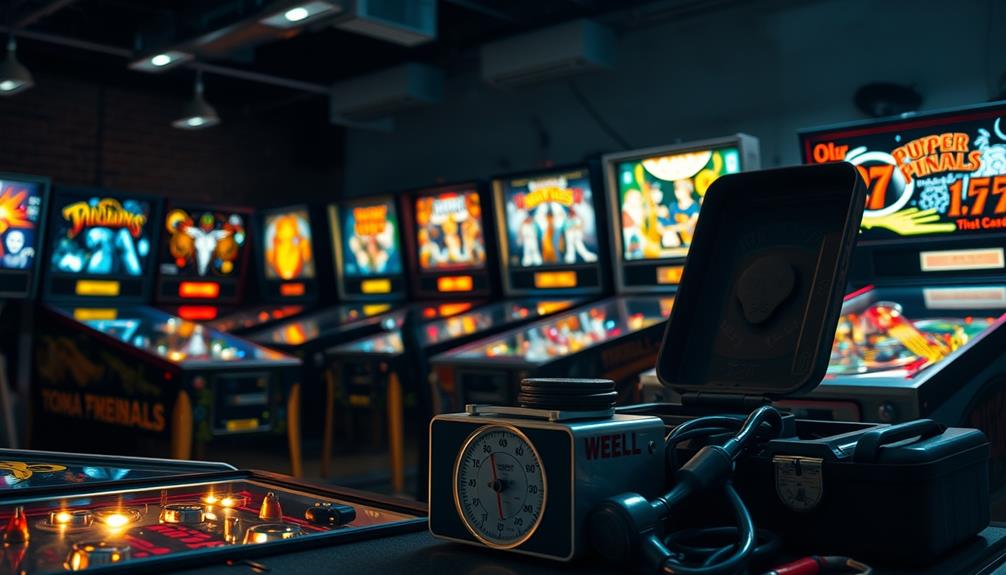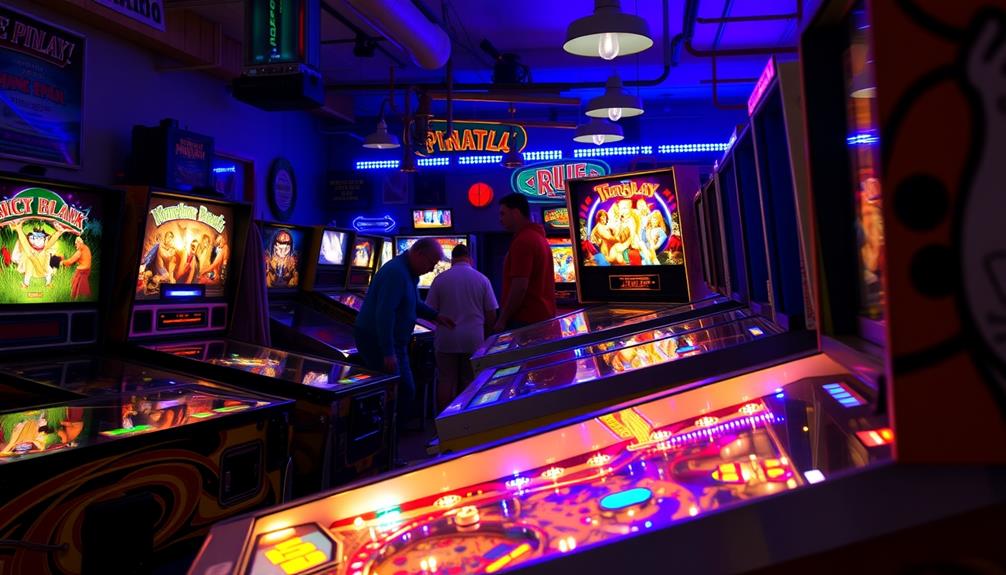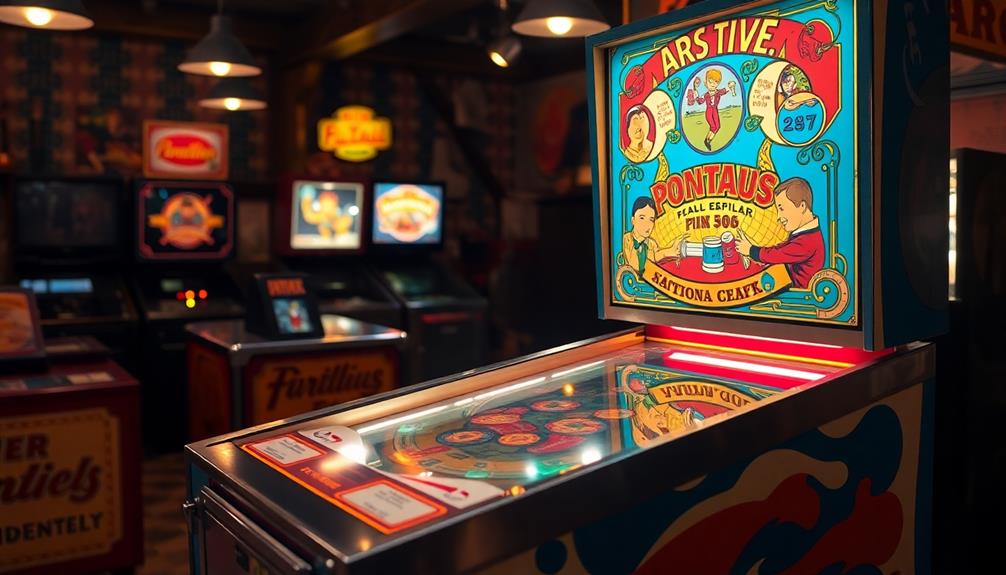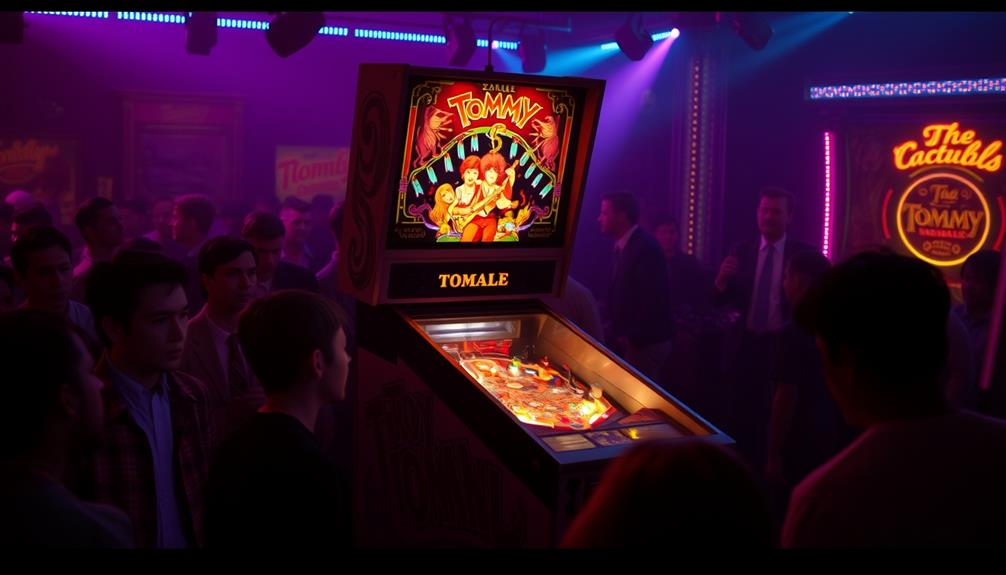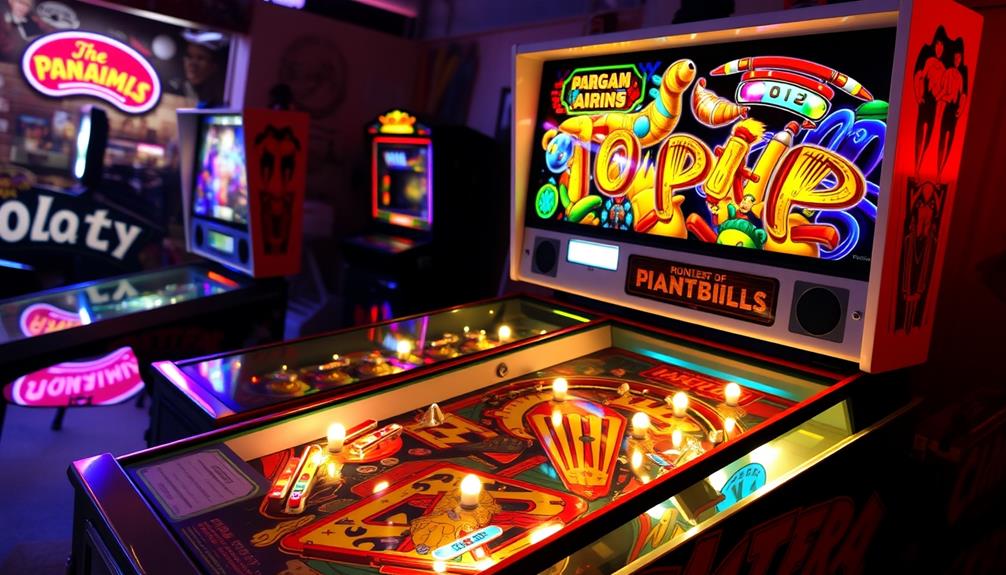Pinball scoring operates by attributing specific point values to your actions, which may vary per machine. Points are earned by hitting targets, completing tasks, or triggering modes- some worth 10 to 50 points, while others can reach into the billions, especially during multiball. The scoring system has progressed from simple mechanical displays to intricate electronic counters, influencing your gameplay. High score limits add excitement and strategy to your gaming experience. Understanding these dynamics can enrich your experience and help you achieve the highest scores possible. There is a lot to learn about how scoring maintains the excitement and competitiveness of the game.
Key Takeaways
- Pinball scoring systems assign varying point values for actions, typically ranging from 10 to 50 points based on difficulty and target location.
- Modern machines can achieve scores in the billions, reflecting competitive gameplay evolution and player engagement.
- High score caps create unique challenges, with notable limits like Psycho Pinball's 999,999,990 points affecting gameplay strategies.
- Scoring techniques have evolved from mechanical displays to advanced electronic systems, enhancing the overall gaming experience.
- Advanced scoring variations, including exponential growth mechanics, challenge player skills and keep gameplay fresh and exciting.
Overview of Pinball Scoring Systems
Pinball scoring systems are a fascinating blend of mechanics and strategy that vary widely from one machine to another. Each game's scoring system assigns different point values to similar actions, enhancing gameplay complexity and keeping you engaged. This variation in scoring is often directly tied to pinball machine design, as different machines possess different layouts, obstacles, and objectives. For example, hitting specific targets or ramps may yield higher point values in one game, while in another game, achieving certain combo sequences may be the key to racking up points. Understanding these nuances in pinball machine design is crucial to mastering the score potential of each game.
You might notice that some machines display inflated scores with arbitrary trailing zeroes, creating a visual appeal that makes achievements feel more substantial. In a similar vein to how astrology claims to influence personality traits, the scoring can have a psychological effect on players, boosting their confidence and enjoyment of the game.
As you play, you'll encounter various targets and switches that reward you with points—ranging from 50 to -10, 30, or 20 points—depending on what you hit. This variability adds excitement to every shot, as you strategize which components to target for maximum scoring.
Modern scoring systems can even reach into the billions of points, reflecting how competitive and evolved pinball has become over the years.
Some machines, like Stern's NBA pinball or Capcom's Flipper Football, incorporate unique scoring systems that mimic real-life sports scoring. This adds layers of familiarity and excitement, inviting you to connect your gaming experience with the thrill of actual sports.
Understanding these scoring systems can greatly enhance your gameplay and strategy, making each session unique and thrilling.
Basic Scoring Mechanics

Understanding the basic scoring mechanics of a pinball machine can greatly enhance your gameplay experience. Each machine has a unique scoring system that assigns varying point values for actions, much like how budgeting can impact financial health.
You'll typically earn 10, 20, or even 50 points depending on the difficulty and location of the target you hit. Activating switches, hitting targets, and completing specific objectives are the primary ways you rack up points, and these can differ considerably between pinball machines.
In multiball modes or special game sequences, scores can skyrocket, with some games like Jackbot allowing totals to exceed ten billion points! For instance, in Stern's NBA Fastbreak, you can score points by mimicking real-life basketball actions, adding an exciting twist to the traditional pinball experience.
As you play, you'll notice how the visual display of scores has evolved from basic rolling counters to advanced electronic systems capable of showcasing astronomical totals.
This evolution not only enhances your ability to track your progress but also amps up the thrill of each shot you take. Understanding these mechanics will help you strategize and improve your overall gameplay.
Evolution of Scoring Techniques

The journey of scoring techniques in pinball has transformed gameplay considerably over the decades. Initially, in the 30s and 40s, scoring relied on simple mechanical displays that often inflated scores with arbitrary zeros. Players didn't always get an accurate picture of their performance, which is reminiscent of how family photoshoot fails can create humorous moments that distract from the intended outcome.
By the 70s, electronic score counters emerged, allowing players to score points into the thousands, and by the 90s, six-digit scores became common. This shift marked a significant leap in how you experience the game.
Today, you might encounter scoring systems that look like this:
- Inflation of Scores: Machines often display scores in the billions, making it essential to strategize for maximum points.
- Complex Scoring Systems: Different games assign varying point values for similar actions, enhancing engagement.
- Trends in Recent Machines: Jersey Jack tables often showcase millions as a moderate achievement, while Stern tables frequently score in the billions.
These advancements not only elevate the competitiveness of pinball but also keep you on your toes, ensuring every shot counts as you chase those high scores!
High Score Limits and Caps

When you play pinball, you might notice that some machines have high score caps that can really shape your gaming experience.
These limitations can create a unique challenge and encourage players to develop new strategies and techniques. For example, while some games like Johnny Mnemonic push the limits with scores nearing a trillion, others like Psycho Pinball reset back to zero after hitting their cap.
Understanding these limitations can help you strategize and aim for those high scores more effectively, especially when you consider the excitement of top hotels with water parks that often feature pinball machines as part of their entertainment offerings.
Score Cap Examples
Score caps play an essential role in shaping gameplay experiences in pinball, as they define the maximum points you can achieve. Understanding these caps can help you strategize better and avoid confusion during your play sessions.
Just like how diversification of retirement portfolios is vital in a volatile economy, recognizing score caps allows players to focus their efforts on achieving high scores without being misled by the numbers.
Here are some notable examples of score caps in popular pinball games:
- Psycho Pinball: This game features a frustrating score cap that loops back after reaching 999,999,990 points, leaving players puzzled about their actual score.
- Johnny Mnemonic: With an impressive score cap set at 999,999,999,990, reaching this limit is a rarity, making it a significant milestone for dedicated players.
- Metroid Prime Pinball: This game imposes a score cap at 199,999,990, which players quickly discover, affecting their approach to high scoring.
Additionally, some titles like Classic Pinball Fantasies have caps just below a trillion, leading to inflated scores exceeding 44 trillion points due to their scoring systems.
Jersey Jack tables also show significant score inflation, where achieving ten million points is considered more modest compared to older games.
Knowing these score caps can enhance your pinball experience and make you a more informed player.
Glitches and Limitations
Steering through the world of pinball scoring can sometimes lead to unexpected glitches and limitations that affect your gameplay. Many machines feature high score caps that can create frustrating situations when you reach them.
| Machine Name | Score Cap | Glitches Noted |
|---|---|---|
| Psycho Pinball | 999,999,990 | Scores loop back, causing confusion |
| Johnny Mnemonic | 999,999,999,990 | Rarely reached; potential for glitches |
| Metroid Prime Pinball | 199,999,990 | Quickly discovered cap limits scores |
| Classic Pinball Fantasies | One trillion minus ten | Records exceeding 44 trillion possible |
These score caps can lead to scoring glitches that players might encounter during intense sessions. For instance, in Psycho Pinball, once you hit the cap, your score resets, which can be disheartening. In contrast, Johnny Mnemonic's massive cap challenges even the best players, but it's rare to see someone reach it without encountering glitches.
Modern machines, particularly from Jersey Jack, have inflated scores where millions are a standard achievement. Keep an eye on these limits as you play, since they can greatly impact your pinball experience!
Historical Score Trends
As players navigate the evolving landscape of pinball, understanding historical score trends reveals how high score limits and caps have drastically changed over the years.
Early machines often displayed inflated scores with arbitrary zeros, which made it tough for you to gauge actual performance. The rise of digital technology has also influenced the scoring systems, leading to more defined parameters and expectations in gameplay, similar to the AI-driven platforms that cater to diverse preferences in adult entertainment.
Today, you'll encounter some fascinating examples of score caps and trends:
- Psycho Pinball: This game mistakenly implemented a score cap, causing scores to loop back after hitting 999,999,990.
- Johnny Mnemonic: Featuring one of the highest known score caps at 999,999,999,990, only a few players have ever reached this limit due to its extremity.
- Classic Pinball Fantasies: This game boasts a high score cap of a trillion minus ten, with records exceeding 44 trillion points, highlighting significant score inflation.
Jersey Jack tables showcase another trend, where achieving ten million points is now seen as a moderate accomplishment compared to earlier standards.
These historical shifts not only reflect advancements in technology but also illustrate how scoring expectations have evolved, making pinball an ever-changing challenge for players like you.
Psychological Impact of Scores

In the world of pinball, players often find themselves captivated by the thrill of chasing high scores. The allure of seeing those numbers light up on the dot matrix display fuels your excitement and determination. You may notice that larger score numbers create a sense of achievement, even if the actual gameplay remains consistent. This cognitive bias can inflate your perception of success, making you believe you're progressing more than you actually are.
Additionally, the energetic alignment experienced during gameplay can enhance your focus and motivation, similar to how nature connection and emotional well-being can boost overall mental performance.
The rapid-fire changes in scores during gameplay evoke a sense of urgency and competition. You're not just playing against the machine; you're competing against yourself and others for that top spot. This competitive drive enhances your overall engagement, pushing you to aim higher each time you play.
Visual feedback from high scores also contributes to your feelings of accomplishment. Despite the arbitrary nature of scoring systems, seeing those big numbers can be immensely satisfying. This desire for recognition and the thrill of competition often propel you to chase scores relentlessly, encouraging both enjoyment and frustration in equal measure.
Ultimately, the psychological impact of scores shapes your pinball experience, making every game a unique blend of challenge and reward.
Advanced Scoring Variations

Advanced scoring variations in pinball introduce a dynamic layer to gameplay that can greatly alter your experience. These variations push the boundaries of traditional scoring and can lead to some jaw-dropping numbers.
For instance, understanding the importance of high refresh rates in gaming can enhance your overall enjoyment of pinball machines. Here are three examples of advanced scoring variations you might encounter:
- Exponential Growth Systems: Similar to idle games, some pinball machines allow scores to soar into quintillions, creating an exhilarating race for high scores.
- Custom Programming: Certain games let you surpass traditional score limits, giving you unique scoring opportunities that can redefine your gameplay.
- Diverse Scoring Mechanics: Games like Sonic use a minimum scoring unit of 100, while Epic Pinball features tables with point values ranging from 1 to 5 digits, showcasing the variety in scoring methods.
Don't forget iconic stages like the Mewtwo bonus in Pokémon Pinball, where you can amass an incredible 50 million points per hit.
These advanced scoring variations enhance your pinball experience and challenge your skills, making every game feel fresh and exciting. Embrace these variations, and you'll find yourself exploring new strategies and aiming for those high scores!
Future Trends in Scoring

With advanced scoring variations setting the stage, future trends in pinball scoring are expected to push the envelope even more. You're likely to witness an increase in inflated scoring systems, with some machines already reaching scores in the quintillions. This trend enhances competitive play, making every point count more than ever.
Moreover, just as energy-efficient models can reduce heating and cooling costs, we may see scoring systems designed to optimize player engagement and enjoyment, creating an even more enthralling gaming experience.
Advanced scoring techniques, similar to exponential growth mechanics in idle games, may become a staple, allowing you to achieve unprecedented score levels. The integration of multiple currencies and scoring systems within games will offer you varied ways to rack up high scores, keeping your interest piqued.
As technology progresses, customizable scoring systems are on the horizon. You'll be able to adjust point values and gameplay dynamics to suit your preferences, making each game truly your own.
Additionally, recent trends suggest scoring will increasingly incorporate visual and auditory feedback, creating a more immersive and exciting experience.
Incorporating all these elements, the future of pinball scoring promises to be dynamic and engaging, ensuring that you stay on the edge of your seat as you aim for those high scores. Additionally, advancements in technology and game design will continue to enhance the immersive experience of pinball scoring, making it even more interactive and competitive. Understanding pinball tilt and how it can affect your game will also play a crucial role in achieving those top scores, adding an extra layer of strategy to the game. With all these innovations, the future of pinball scoring is sure to keep players coming back for more thrilling challenges and excitement.
Frequently Asked Questions
How Does a Pinball Game Work?
In a pinball game, you control flippers to launch the ball, hitting targets and ramps to score points. You navigate the playfield, activating features and modes, aiming for high scores and thrilling gameplay experiences.
Is Pinball Luck or Skill?
Pinball's a dance between luck and skill. You can control your flippers, aiming for targets, but sometimes the ball takes unexpected bounces. Mastering the game means blending strategy with a bit of chance.
What Is the Number at the End of a Pinball Game?
The number at the end of a pinball game reflects your total score, showcasing your performance. It can vary widely, influenced by actions you take, bonuses you earn, and the machine's unique scoring system.
How Does Pinball Loss Work?
Losing a ball feels like defeat, yet it sharpens your focus. You've got three chances, but drain a ball, and your turn ends. It's all about skill, strategy, and seizing every scoring opportunity.
Conclusion
To sum up, pinball scoring has evolved remarkably, blending classic mechanics with innovative techniques. Did you know that approximately 70% of pinball players cite achieving high scores as their primary motivation? This statistic highlights the thrill and challenge that scoring brings to the game. As you play, remember that each flip of the flipper not only aims for points but also enhances your skills and strategy, making every game a unique experience. Keep aiming high!

